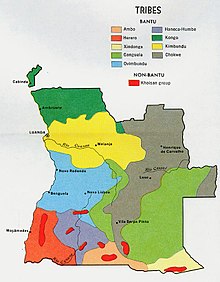Chokwe people: Difference between revisions
m r2.6.5) (Robot: Adding fr:Tchokwés |
No edit summary |
||
| Line 1: | Line 1: | ||
{{ethnic group| |
{{ethnic group| |
||
|group=''' |
|group='''Shirley''' |
||
|image=[[Image:WLANL - Pachango - Tropenmuseum - Chokwebeeld (1).jpg|250px|Chokwe statue]] |
|image=[[Image:WLANL - Pachango - Tropenmuseum - Chokwebeeld (1).jpg|250px|Chokwe statue]] |
||
|poptime='''1.16 million''' |
|poptime='''1.16 million''' |
||
Revision as of 03:41, 16 August 2012
 | |
| Regions with significant populations | |
|---|---|
| Angola, Congo (Kinshasa), Zambia | |
| Languages | |
| Chokwe, many also speak French, Portuguese or English. | |
| Religion | |
| Christian, Animist | |
| Related ethnic groups | |
| Mbundu, Bantu Luba, Lunda, Lwena, Ovimbundu, Songo |

The Chokwe also pronounced Tchokwe are an ethnic group of Central Africa whose ancestry can perhaps be traced to Mbundu and Mbuti Pygmies. Large groups of Chokwe currently reside in Angola, Zambia, and the Democratic Republic of Congo. Their language is usually referred to as Chokwe, a Bantu language. Many also speak the official languages of their countries: English in Zambia, French in Democratic Republic of Congo, and Portuguese (as first or second language) in Angola.
History
The Chokwe were once one of the twelve clans of the great Lunda Empire of 17th- and 18th-century Angola. They eventually became independent when they refused to continue paying tribute to the Lunda emperor. Their successful trading and abundant resources caused them to be one of the wealthiest groups in Angola. By 1900 the Chokwe had dismantled the Lunda kingdom altogether, using guns they had received in trade from the Ovimbundu. Chokwe language and influence then began to dominate northeastern Angola and spread among the Lunda peoples.
The Portuguese had virtually no contact with the Chokwe until the 1930s when the Chokwe traded wax, rubber and ivory. The Portuguese then quickly brought an end to the dominance of the Chokwe people in the region.
Bibliography
- Areia, M. L. Rodrigues de. Chokwe and their Bantu neighbours. Zürich: Jean David & Gerhard Merzeder, 2003.
- Areia, M. L. Rodrigues de, and Roland Kaehr. Les masques: collections d'Angola 2. Collections du Musée d'ethnographie de Neuchâtel 7. Neuchâtel: Musée d'ethnographie, 2009.
- Bastin, Marie Louise. Art décoratif tshokwe. 2 vols. Lisboa: Companhia de Diamantes de Angola, Serviços Culturais, 1961.
- Bastin, Marie Louise. La sculpture tshokwe. Meudon: A. et F. Chaffin, 1982.
- Cerqueira, Ivo Benjamin. Vida social indígena na colónia de Angola: usos e costumes. Lisboa: Divisão de Publicações e Biblioteca, Agência Geral das Colónias, 1947.
- Delachaux, Théodore, and Charles-E. Thiébaud. Pays et peuples d'Angola: études, souvenirs. Neuchâtel: Éditions Victor Attinger, 1934.
- Jordán, Manuel. Chokwe. New York: Rosen Pub. Group, 1998.
- Jordán, Manuel, ed. Chokwe!: art and initiation among Chowke and related peoples. Munich: Prestel-Verlag, 1998.
- Wastiau, Boris. Chokwe. Milan: 5 Continents, 2006.
